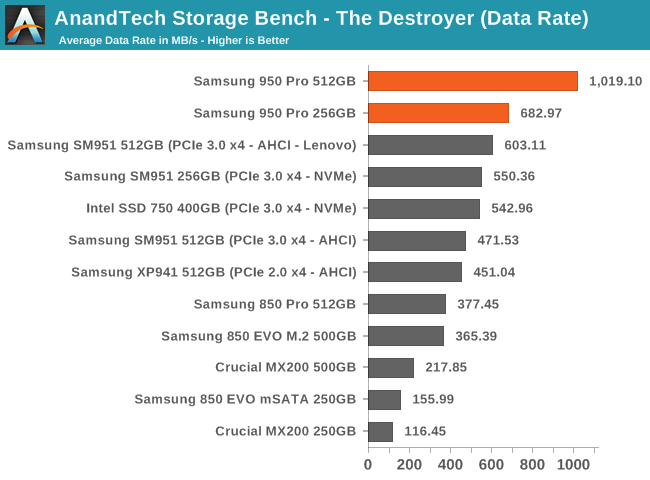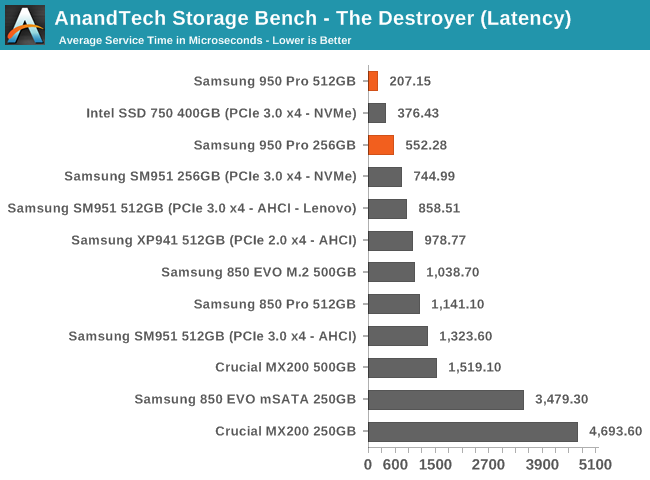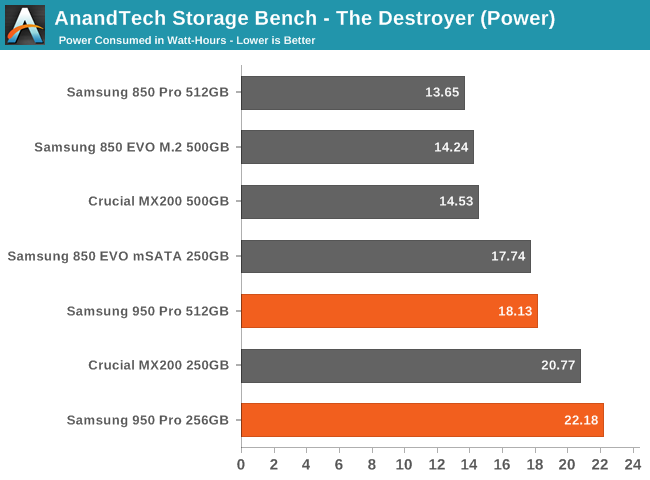The Samsung 950 Pro PCIe SSD Review (256GB and 512GB)
by Billy Tallis on October 22, 2015 10:55 AM ESTAnandTech Storage Bench - The Destroyer
The Destroyer is an extremely long test replicating the access patterns of heavy desktop usage. A detailed breakdown can be found in this review. Like real-world usage and unlike our Iometer tests, the drives do get the occasional break that allows for some background garbage collection and flushing caches, but those idle times are limited to 25ms so that it doesn't take all week to run the test.
We quantify performance on this test by reporting the drive's average data throughput, a few data points about its latency, and the total energy used by the drive over the course of the test.

Both 950 Pros deliver great performance on the destroyer, but the 512GB is outstanding. Clearly the more bursty nature of this test allows the drive to avoid any thermal throttling and deliver the high peak speeds that the PCIe interface is supposed to enable.

The NVMe drives deliver the lowest average service times, but the other PCIe drives are close behind. If there were any moments of thermal throttling like we saw with the performance consistency test, they would greatly inflate the average service time.

The very small number of performance outliers on this test is a good indicator that these drives don't sieze up under the pressure of an interactive workload.

When looking at the more strict latency threshold of 10ms, the 256GB 950 Pro is not significantly better than the good SATA drives, but the 512GB has extremely good control over latency.

Energy usage is not competitive with the high-performance SATA drives. As demanding as it is, The Destroyer still has opportunities for drives to scale back power consumption but the 950 Pro can't do that on our testbed.










142 Comments
View All Comments
MHz Tweaker - Monday, November 16, 2015 - link
I have an IT service company and have been doing IT for a few decades. I am with you on how incredibly annoying it is to work on some of the hodge podge of hardware that comes in for service. Specifically there are those that refuse to upgrade early P4's or Sempron single core systems with 512 or 256 megs of RAM. Certainly these should have failed by now. They barely run XP let alone modern security needed to protect them. Internally all our workstations are Z97, X99, x79, Z170's with 4690K's, 4790K's, 5930K, 3930K and 6700K CPUs. Every machine has a Samsung or Intel SSD for a boot drive and a Hitachi 4, 5 or 6TB drive for work and storage. All systems also have 16 or 32GB RAM. I am just amazed at how much time the average person wastes waiting on an entry level PC to do things. I mean many of us spend in excess of 40 hours a week at a keyboard. I get much more done when I keep my equipment in tip top shape and fresh. Nothing has a chance to break down. Many companies throw tons of money at "image" but internally the infrastructure is held together with bubble gum and band aids.Oh BTW, I got our first 950 Pro 512MB Yesterday :-)
Deders - Thursday, October 22, 2015 - link
Until Samsung announce again that SSD's are not meant to use sleep, their excuse for computers with 830/840's freezing for 30 seconds after waking up.BurntMyBacon - Friday, October 23, 2015 - link
@Deders: "Until Samsung announce again that SSD's are not meant to use sleep, their excuse for computers with 830/840's freezing for 30 seconds after waking up."Is this a known issue or are you just speculating about what might (probably?) occur in the future?
I am using quite a few 830s and have deployed quite a few more all (up to this point) without this issue. In my experience, they've been some of the most reliable drives I've used. I know of a few 840s without issues as well, but I've tried to avoid them as much as practical as I'm still not convinced the industry fully understands the long term consequences of simultaneously increasing leakage and cutting down the margin of error to get that third (fourth, fifth, etc.) bit in. I suspect it'll be fine on some (larger) process nodes, but the 840EVO issues suggests that there is a lower limit to how small you can get while trying to get that extra bit (and storing long term). In any case, it would be nice to know if there is something I should be looking out for here and whether practical mitigations exist.
bill.rookard - Sunday, October 25, 2015 - link
Agreed. I have several systems with the 830s in them and have zero problems with them. I avoided the 840s because those went with the TLC and I was iffy about them, and the 830s are rock solid and very fast.Chaser - Tuesday, October 27, 2015 - link
Boot times matter to me too. Makaveli must have a remote control while he's making his bagels.carl0ski - Monday, May 16, 2016 - link
I'd say the most annoying part is the Windows boot logo is a fixed time to complete.So even if Windows 7 8 10 boot up faster it still waits for the pretty video.
Turn it off from msconfig and windows 7 on 850 will boot in 3 seconds instead of 10 seconds
beginner99 - Thursday, October 22, 2015 - link
Most people that buy such a product usually are enthusiast and play around like over clocking. 10 sec more per boot is then pretty annoying.Makaveli - Thursday, October 22, 2015 - link
I'm from the era of overclocking with jumpers on a motherboard and far longer post times. If waiting 10 seconds for a machine to boot is too long while trying to get a stable overclock then do it in windows. Or does everyone in this generation have ADD?AnnonymousCoward - Thursday, October 22, 2015 - link
Oh, so time is only valuable to those with ADD? You're a fool.Makaveli - Thursday, October 22, 2015 - link
Go troll else where tool!